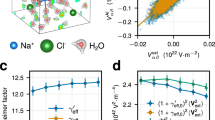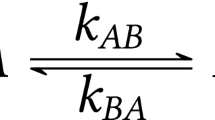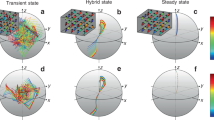Abstract
THE phenomenon of nuclear spin-lattice relaxation for 17O in isotopically enriched water has previously been discussed1,2. The relaxation times for 17O compounds are governed entirely by the rotational reorientation times of the molecules, because of the very large electric quadrupole moment of the 17O nucleus. This is not true for spin S = ½ nuclei such as 1H. For these, spin-lattice relaxation is governed both by intramolecular (rotational) motions and intermolecular motions (relative motions of other neighbouring nuclear or electron magnetic moments). Proton relaxation times are very susceptible to the presence of dissolved paramagnetic impurities while 17O relaxation is very much less sensitive. In the past the sensitivity of proton relaxation times to this factor has caused some trouble with the interpretation of relaxation times in solutions of biopolymers3.
This is a preview of subscription content, access via your institution
Access options
Subscribe to this journal
Receive 51 print issues and online access
$199.00 per year
only $3.90 per issue
Buy this article
- Purchase on Springer Link
- Instant access to full article PDF
Prices may be subject to local taxes which are calculated during checkout
Similar content being viewed by others
References
Glasel, J. A., Proc. US Nat. Acad. Sci., 55, 479 (1966).
Glasel, J. A., Proc. US Nat. Acad. Sci., 58, 27 (1967).
Douglass, D. C., Frisch, H. L., and Anderson, E. W., Biochim. Biophys. Acta, 44, 401 (1960).
Abragam, A., The Principles of Nuclear Magnetism, 300, 314 (Oxford, 1961).
Meiboom, S., J. Chem. Phys., 34, 375 (1961).
Abragam, A., J. Chem. Phys., 34, 57 (1961).
Buchanan, T. J., Haggis, G. H., Hasted, J. B., and Robinson, B. G., Proc. Roy. Soc., A, 213, 379 (1952).
Daszkiewicz, O. K., Hennel, J. W., Lubas, B., and Szczepkowski, T. W., Nature, 200, 1006 (1963).
Ragozzino, E., Mol. Phys., 10, 497 (1966).
Author information
Authors and Affiliations
Rights and permissions
About this article
Cite this article
GLASEL, J. 17O Nuclear Magnetic Relaxation in a Protein–Water System. Nature 218, 953–955 (1968). https://doi.org/10.1038/218953a0
Received:
Issue Date:
DOI: https://doi.org/10.1038/218953a0
This article is cited by
-
Hydration of monosaccharides: A study by dielectric and nuclear magnetic relaxation
Journal of Solution Chemistry (1972)
-
Magnetic Relaxation in Ordered Systems
Nature (1970)
-
Magnetic Relaxation Studies of Protein Solvation
Nature (1968)
Comments
By submitting a comment you agree to abide by our Terms and Community Guidelines. If you find something abusive or that does not comply with our terms or guidelines please flag it as inappropriate.



